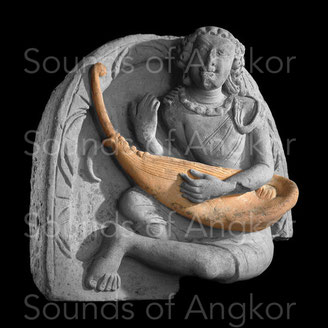Last update: December 5, 2023
The harp has probably reached South Asia since the former Near East. There is no tangible proof, but the instrument already exists in the civilization of the Indus (about 3000-1750 BCE), a period of commerce with the Mesopotamia. The Sāmaveda (circa 1800-1500 BCE) is the first to mention the word vīṇa, a generic term for chordophones for ritual use. The text does not specify whether it is harps, zithers or lutes. Later, around 500 BCE, classical Indian literature mentions it as an instrument of court entertainment. This last role is confirmed through the Buddhist art of 2nd century BCE to 6tth century CE where kings, nobles, minor deities and courtesans are represented playing the harp, either solo, or to accompany the song and animate the dance. The harp continues to appear sporadically in the iconography of the end of the first millennium, to disappear gradually in South Asia, with some exceptions: waji from Nuristan, bin-baja of Pardhan from Madhya Pradesh (India), t'na or nade of Karen from Myanmar and Thailand, saùng-gauk of Burmese.
The pre-angkorian harp through iconography
The oldest representations of harps appear in the 7th century on two lintels of Sambor Prei Kuk, today in the National Museum of Cambodia. Another one is in the Pakse Museum, discovered on the Laotian territory, formerly partly included in the Khmer Empire.
About the top section
The harp of Pawaya (India)

The recent discovery for us (October 2018) of the existence of the lintel of Pawaya, visible in the Gujari Mahal Archeological Museum also known as the Gwalior Fort Archeologic Museum, confirms several points of organology present on our reconstruction's work of the pre-angkorian harp.
1. The general arched shape of the harp is confirmed.
2. A volute is present at the top of the neck.
3. The necklaces that attach the strings to the neck are perfectly visible.
4. The number of strings seems to be seven even though this type of data is still to be taken with caution. However, he tells us that he is neither very inferior nor superior. This data can easily be adapted to each production.
5. The sculpture also shows us that a skin had to be used to make the soundboard; it stops at the base of the neck.
On the other hand, we don't know if the instrument had feet to keep it standing when it was not played.
In a general way, everything is quite precise in this relief, both on the organological level and in the musician-instrument relationship.
In addition, the composition of the orchestra is similar to the lists of instruments of the Lolei temple (9th century).
The pre-Angkorian harp through epigraphy
In the ancient Khmer epigraphy, the harp is invariably referred to as vīṇa. However, the word is ambiguous as it refers to a wide range of string instruments in India, especially the stick and tube zither. In India, a prefix or suffix specifies the nature of the vīṇa. In Cambodia, it is necessary to distinguish texts in Sanskrit from those in ancient Khmer. If it is proved that this term designates the harp in ancient Khmer, it must be translated as "zither" in Sanskrit text. The inscription of Angkor Borei (K. 557 and K. 600) (611 CE) mentions four female harp players among the temple's servants;
Movie: Mysteries of the Khmer harp
The Khmer harp, which has probably been missing since the 14th-15th centuries from Cambodia, fantasize generations of musicians and intellectuals. The ethnomusicologist Patrick Kersalé has been exploring remote areas of Southeast Asia and India for more than 20 years, tracks the footsteps of this legendary instrument to try to unravel the mystery. His dream: to rebuild the Angkorian harp and restore the orchestras of the glorious past of the Khmer Empire.







